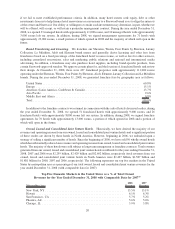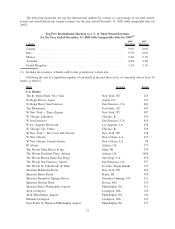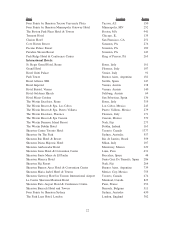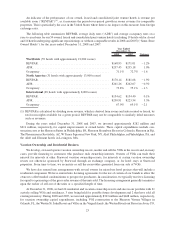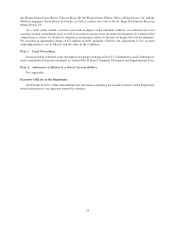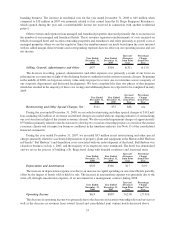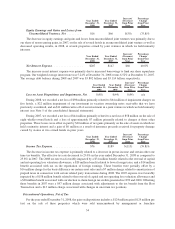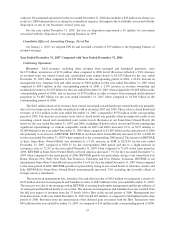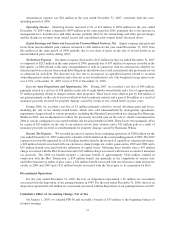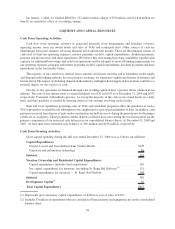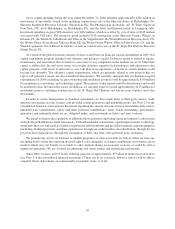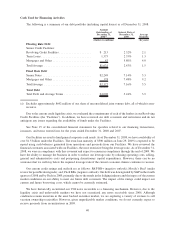Starwood 2008 Annual Report Download - page 96
Download and view the complete annual report
Please find page 96 of the 2008 Starwood annual report below. You can navigate through the pages in the report by either clicking on the pages listed below, or by using the keyword search tool below to find specific information within the annual report.Frequent Guest Program. SPG is our frequent guest incentive marketing program. SPG members earn
points based on spending at our properties, as incentives to first time buyers of VOIs and residences and through
participation in affiliated programs. Points can be redeemed at substantially all of our owned, leased, managed
and franchised properties as well as through other redemption opportunities with third parties, such as conversion
to airline miles. Properties are charged based on hotel guests’ qualifying expenditures. Revenue is recognized by
participating hotels and resorts when points are redeemed for hotel stays.
We, through the services of third-party actuarial analysts, determine the fair value of the future redemption
obligation based on statistical formulas which project the timing of future point redemption based on historical
experience, including an estimate of the “breakage” for points that will never be redeemed, and an estimate of the
points that will eventually be redeemed as well as the cost of reimbursing hotels and other third parties in respect of
other redemption opportunities for point redemptions. Actual expenditures for SPG may differ from the actuarially
determined liability. The total actuarially determined liability as of December 31, 2008 and 2007 is $662 million
and $536 million, respectively. A 10% reduction in the “breakage” of points would result in an estimated increase of
$85 million to the liability at December 31, 2008.
Long-Lived Assets. We evaluate the carrying value of our long-lived assets for impairment by comparing the
expected undiscounted future cash flows of the assets to the net book value of the assets if certain trigger events
occur. If the expected undiscounted future cash flows are less than the net book value of the assets, the excess of the
net book value over the estimated fair value is charged to current earnings. Fair value is based upon discounted cash
flows of the assets at a rate deemed reasonable for the type of asset and prevailing market conditions, appraisals and,
if appropriate, current estimated net sales proceeds from pending offers. We evaluate the carrying value of our long-
lived assets based on our plans, at the time, for such assets and such qualitative factors as future development in the
surrounding area, status of expected local competition and projected incremental income from renovations.
Changes to our plans, including a decision to dispose of or change the intended use of an asset, can have a
material impact on the carrying value of the asset.
Loan Loss Reserves. For the vacation ownership and residential segment, we record an estimate of expected
uncollectibility on our VOI notes receivable as a reduction of revenue at the time we recognize profit on a sale of a
vacation ownership interest. We hold large amounts of homogeneous VOI notes receivable and therefore assess
uncollectibility based on pools of receivables. In estimating our loss reserves, we use a technique referred to as static
pool analysis, which tracks uncollectible notes for each year’s sales over the life of the respective notes and projects
an estimated default rate that is used in the determination of our loan loss reserve requirements. As of December 31,
2008, the average estimated default rate for our pools of receivables was 7.9%. Given the significance of our
respective pools of VOI notes receivable, a change in the projected default rate can have a significant impact to our
loan loss reserve requirements, with a 0.1% change estimated to have an impact of approximately $3 million.
For the hotel segment, we measure the impairment of a loan based on the present value of expected future cash
flows discounted at the loan’s original effective interest rate or the estimated fair value of the collateral. For
impaired loans, we establish a specific impairment reserve for the difference between the recorded investment in the
loan and the present value of the expected future cash flows or the estimated fair value of the collateral. We apply the
loan impairment policy individually to all loans in the portfolio and do not aggregate loans for the purpose of
applying such policy. For loans that we have determined to be impaired, we recognize interest income on a cash
basis.
Assets Held for Sale. We consider properties to be assets held for sale when management approves and
commits to a formal plan to actively market a property or group of properties for sale and a signed sales contract and
significant non-refundable deposit or contract break-up fee exist. Upon designation as an asset held for sale, we
record the carrying value of each property or group of properties at the lower of its carrying value which includes
allocable segment goodwill or its estimated fair value, less estimated costs to sell, and we stop recording
depreciation expense. Any gain realized in connection with the sale of a property for which we have significant
continuing involvement (such as through a long-term management agreement) is deferred and recognized over the
initial term of the related agreement. The operations of the properties held for sale prior to the sale date are recorded
in discontinued operations unless we will have continuing involvement (such as through a management or franchise
agreement) after the sale.
30


